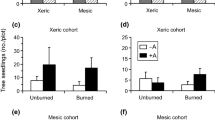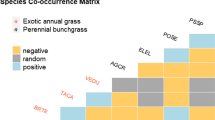Abstract
We quantified the effects of exotic annual grass invasion on the ground-layer structure of grassy eucalypt woodlands, with the aim of determining if weed invasion decreased gap size and plant basal area leading to reduced spatial heterogeneity. We measured plant density, distance between plants and basal plant area in woodland sites which ranged from zero to 100% exotic plant cover in the ground-layer. The ground-layer in uninvaded woodlands was heterogeneous, with a large variation in basal plant area and distance between plants. Exotic annual grass density was positively correlated with total plant density, whereas native plant density was negatively correlated. Total plant basal area decreased as total plant density increased, with a lower total plant area in exotic dominated transects compared to native dominated. Variation in basal plant area decreased with increasing plant density. Exotic annual grasses were more closely spaced together (smaller gap size) and had a smaller basal area than the native grasses and rushes. There was also less variation in basal area and gap size with individual exotic annual grasses compared to the native grasses. Inter-plant distance was greater for both the native and exotic grasses when they had native grasses neighbouring them instead of exotic grasses. These findings show that woodlands invaded by exotic annual grasses have relatively less spatial heterogeneity in the ground-layer. These results have implications for other aspects of perennial grassy ecosystems invaded by annual grasses, including plant recruitment and restoration strategies.




Similar content being viewed by others
References
Allan GE, Southgate RI (2002) Fire regimes in the spinifex landscapes of Australia. In: Bradstock RA, Williams JE, Gill AM (eds) Flammable Australia. Cambridge University Press, Cambridge, pp 145–176
Becker DA, Crockett JJ (1973) Evaluation of sampling techniques on tall-grass prairie. J Range Manag 26:61–65
Belnap J, Phillips J (2001) Soil biota in an ungrazed grassland: response to annual grass (Bromus tectorum) invasion. Ecol Appl 11:1261–1275
Bergelson J, Newman JA, Floresroux EM (1993) Rates of weed spread in spatially heterogeneous environments. Ecology 74:999–1011
Catana AJ (1963) The wandering quarter method of estimating population density. Ecology 44:349–360
Clarke PJ, Davison EA (2004) Emergence and survival of herbaceous seedlings in temperate grassy woodlands: recruitment limitations and regeneration niche. Austral Ecol 29:320–331
Cogger HG (1984) Reptiles in the Australian arid zone. In: Cogger HG, Cameron EE (eds) Arid Australia. Australian Museum, Sydney, pp 235–252
Cole I, Lunt ID, Koen T (2004) Effects of soil disturbance, weed control and mulch treatments on establishment of Themeda triandra (Poaceae) in a degraded white box (Eucalyptus albens) woodland in central western New South Wales. Aust J Bot 52:629–637
Dillemuth F, Rietschier E, Cronin J (2009) Patch dynamics of a native grass in relation to the spread of invasive smooth brome (Bromus inermis). Biol Invasions 11:1381–1391
DiVittorio CT, Corbin JD, D’Antonio CM (2007) Spatial and temporal patterns of seed dispersal: an important determinant of grassland invasion. Ecol Appl 17:311–316
Dorrough J, Moxham C, Turner V, Sutter G (2006) Soil phosphorus and tree cover modify the effects of livestock grazing on plant species richness in Australian grassy woodland. Biol Conserv 130:394–405
French K, Ens E, Gosper C, Lindsay E, Mason T, Owens B, Sullivan N (2008) Management implications of recent research into the effect of bitou bush invasion. Plant Prot Q 23:24–28
Gentle CB, Duggin JA (1997) Allelopathy as a competitive strategy in persistent thickets of Lantana camara L. in three Australian forest communities. Plant Ecol 132:85–95
Gordon DR (1998) Effects of invasive, non-indigenous plant species on ecosystem processes: lessons from Florida. Ecol Appl 8:975–989
Groves RH, Austin MP, Kaye PE (2003) Competition between Australian native and introduced grasses along a nutrient gradient. Austral Ecol 28:491–498
Harden GJ (1992–2007) Flora of New South Wales, vol I–IV. University of New South Wales Press and Botanic Gardens Trust, Sydney
Hautier Y, Niklaus PA, Hector A (2009) Competition for light causes plant biodiversity loss after eutrophication. Science 324:636–638
Holmes TH, Rice KJ (1996) Patterns of growth and soil-water utilization in some exotic annuals and native perennial bunchgrasses of California. Ann Bot 78:233–243
Jessop J, Dashorst GRM, James FM (2006) Grasses of South Australia: an illustrated guide to the native and naturalised species. Wakefield Press, Kent Town
Lassau SA, Hochuli DF (2004) Effects of habitat complexity on ant assemblages. Ecography 27:157–164
Lenz TI, Facelli JM (2006) Correlations between environmental factors, the biomass of exotic annual grasses and the frequency of native perennial grasses. Aust J Bot 54:655–667
Lindsay EA, Cunningham SA (2009) Livestock grazing exclusion and microhabitat variation affect invertebrates and litter decomposition rates in woodland remnants. For Ecol Manag 258:178–187
Lindsay EA, Cunningham SA (2011) Native grass establishment in grassy woodlands with nutrient enriched soil and exotic grass invasion. Restor Ecol 19:131–140
Lindsay EA, Collof MJ, Gibb N, Wakelin SA (2010) Microbial functional gene abundance in grassy woodlands is influenced more by soil nutrient enrichment than recent weed invasion or livestock exclusion. Appl Environ Microbiol 76:5547–5555
Lodge GM, Whalley RDB (1985) The manipulation of species composition of natural pastures by grazing management on the northern slopes of New South Wales. Rangeland J 7:6–16
Ludwig JA, Wilcox BP, Breshears DD, Tongway DJ, Anton CI (2005) Vegetation patches and runoff-erosion as interacting ecohydrological processes in semiarid landscapes. Ecology 86:288–297
Lunt I, Barlow T, Ross J (1998) Plains wandering: exploring the grassy plains of south- eastern Australia. Victorian National Parks Association and the Trust for Nature, Melbourne
MacDougall AS, Turkington R (2005) Are invasive species the drivers or passengers of change in degraded ecosystems? Ecology 86:42–55
Mack RN (1981) Invasion of Bromus tectorum L. into Western North America: an ecological chronicle. Agro-Ecosyst 7:145–165
McIntyre S, Lavorel S (2007) A conceptual model of land use effects on the structure and function of herbaceous vegetation. Agric Ecosyst Environ 119:11–21
Melbourne BA, Cornell HV, Davies KF, Dugaw CJ, Elmendorf S, Freestone AL, Hall RJ, Harrison S, Hastings A, Holland M, Holyoak M, Lambrinos J, Moore K, Yokomizo H (2007) Invasion in a heterogeneous world: resistance, coexistence or hostile takeover? Ecol Lett 10:77–94
Morgan JW (1998) Importance of canopy gaps for recruitment of some forbs in Themeda triandra dominated grasslands in south-eastern Australia. Aust J Bot 46:609–627
Parker IM (2000) Invasion dynamics of Cystis scoparius: a matrix model approach. Ecol Appl 10:726–743
Payne RW, Harding SA, Murray DA, Soutar DM, Baird DB, Glaser AI, Channing IC, Welham SJ, Gilmour AR, Thompson R, Webster R (2009) GenStat for windows, 12th edn. VSN International Limited, Hertfordshire
PlantNET (1999–2009) The plant information network system of the botanic gardens trust version 2.0. Retrieved from http://plantnet.rbgsyd.nsw.gov.au/. Accessed on Dec 2008
Platt WJ, Weis IM (1977) Resource partitioning and competition within a guild of fugitive prairie plants. Am Nat 111:479–513
Prober S, Lunt I (2009) Restoration of Themeda australis swards suppresses soil nitrate and enhances ecological resistance to invasion by exotic annuals. Biol Invasions 11:171–181
Prober SM, Thiele KR (2004) Floristic patterns along an east-west gradient in grassy box woodlands of Central New South Wales. Cunninghamia 8:306–325
Prober SM, Lunt ID, Thiele KR (2002a) Determining reference conditions for management and restoration of temperate grassy woodlands: relationships among trees, topsoils and understorey flora in little-grazed remnants. Aust J Bot 50:687–697
Prober SM, Thiele KR, Lunt ID (2002b) Identifying ecological barriers to restoration in temperate grassy woodlands: soil changes associated with different degradation states. Aust J Bot 50:699–712
Quinn GP, Keough MJ (2002) Experimental design and data analysis for biologists. Cambridge University Press, Australia
Silvertown JW (1981) Micro-spatial heterogeneity and seedling demography in species-rich grassland. New Phytol 88:117–128
Silvertown J, Smith B (1989) Mapping the microenvironment for seed germination in the field. Ann Bot 63:163–167
Theoharides KA, Dukes JS (2007) Plant invasion across space and time: factors affecting nonindigenous species success during four stages of invasion. New Phytol 176:256–273
Tongway DJ, Ludwig JA (1997) The conservation of water and nutrients within landscapes. In: Ludwig JA, Tongway DJ, Freudenberger DO, Noble JC, Hodgkinson KC (eds) Landscape ecology, function and management: principles from Australia’s rangelands. CSIRO Publishing, Melbourne, pp 13–22
Acknowledgments
We would like to thank Graham Teakle for field work assistance, Matt Colloff, Karel Mokany and an anonymous referee for useful comments and the Grassy Box Woodland Conservation Management Network for assistance with locating field sites. We are grateful to all the private landholders and the Rural Lands Protection Board for allowing us access to field sites. This work was funded by the Land and Water Australia ‘Defeating the Weed Menace’ program.
Author information
Authors and Affiliations
Corresponding author
Rights and permissions
About this article
Cite this article
Lindsay, E.A., Cunningham, S.A. Effects of exotic grass invasion on spatial heterogeneity in the ground-layer of grassy woodlands. Biol Invasions 14, 203–213 (2012). https://doi.org/10.1007/s10530-011-9997-7
Received:
Accepted:
Published:
Issue Date:
DOI: https://doi.org/10.1007/s10530-011-9997-7




